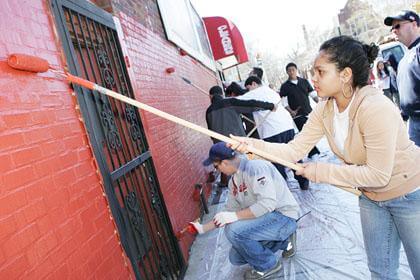By Jeremy Walsh
On a sunny spring morning in East Elmhurst, a small convoy of police vans converged on 98th Street and Astoria Boulevard next to a graffiti−covered dry cleaner shop.
If the story ended there, one might expect what ensued was a raid or arrest. Instead, more than a dozen children and teenagers poured out of the vehicles, rolled up their sleeves and spent the next hour coating the old bricks in new paint.
It was part of a program masterminded by Sgt. Ray Morales with the NYPD’s Community Affairs Unit of Queens Borough Patrol North, who wants to expand the NYPD Youth Explorers’ graffiti clean−up program to get church youth groups involved throughout the borough.
“I think it’s the perfect avenue for Queens−based community groups with lots of kids,” he said.
The children, who hailed from the Iglesia Centro Biblico in Corona and Corona’s Our Lady of Sorrows Church, appeared to enjoy themselves as they grabbed paint rollers last Thursday and did their best not to drip anything on their Air Jordans.
“I think it’s great because it’s helping out the community and giving us a better [image],” said Javier Collado, 14, noting he disapproved of the proliferation of graffiti on his own block. “All it’s doing is just hurting our view of people.”
George and Mery Berrio, youth pastors at Iglesia Centro Biblico, said they jumped at the chance to work with the precinct.
“Youth can be proactive in the community,” she said. “It’s a great way for them to see the other side of the police force.”
Neighbors approved of the work, too.
“I think it’s excellent,” said East Elmhurst resident Joey Mitchell, 60, noting that graffiti plagues the neighborhood. “It’s out of hand. You can look up on the roofs of some of these buildings — what are the kids doing up there?”
Graffiti has a vast underground vocabulary. Painted works can be “throwups,” hastily done signatures or unfilled bubble scripts, or a “piece,” a more elaborate painting using multiple colors and taking a significant time to complete.
Graffiti artists use spray paint, various permanent markers, permanent inks and even a combination of shoe polish and etching acid.
Officer Michael Ferrante, graffiti coordinator for the 115th Precinct, said he once asked a teen why he was carrying a tin of silver shoe polish.
“He said, ‘I like to keep my shoes shiny,’” Ferrante said. “He was wearing white sneakers.”
Graffiti arrests count as felonies if the property clean−up costs more than $250. These days, he said, that means most examples are felonies.
Police also said graffiti rivalries can turn violent. Simple, three−letter notations like “BOS” or “KOS” painted over a tag can mean “beat on sight” or “kill on sight,” Ferrante said. But he added that most of the spray−painting done in Jackson Heights, Corona and East Elmhurst is not the work of any serious gang members.
“Most of it, they just want to be known,” he said. “They want to be considered all−city.”
After eight years on the job and two years as graffiti coordinator, Ferrante said he has come to appreciate the skill inherent in some of the vandals’ work.
“I try to tell the kid, ‘You’re doing good work. Why are you putting it on other people’s property? Why don’t you put it on canvas? Why not get paid?’” he said.
Those interested in joining the graffiti cleanup group can contact Morales at 718−352−7976.
Reach reporter Jeremy Walsh by e−mail at jewalsh@cnglocal.com or by phone at 718−229−0300, Ext. 154.

































